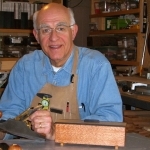Table shelf movement and joinery

My sister-in-law wants a cherry entrance hall table 36W x 16D x 31H with square tapered legs (1 1/2 inches square tapering to about 1 inch) and a shelf about 5 inches off the floor with the shelf fitting flush with and around two sides of each leg. The tapers would be only on the two outside faces of the legs, not the inside faces which would meet flush with the edges of the shelf.
I compute the movement of a 16-inch wide black cherry shelf (to be used in an Atlanta air-conditioned condo) to be about 3/8 inch seasonally. Can the shelf be fixed between the front and back legs allowing the legs to flex to accomodate the movement? If not, how is the movement handled? What joinery is the better way to attach the shelf to the legs?
Or is the better answer to have stretchers between the front and back legs with a proportionately narrower shelf resting on the stretchers and attached to the stretchers with screws through elongated holes? However, from a design point of view, I’m not keen about this solution.
I look forward to your answer.















Replies
Hi Larry,
Dealing with a solid wood shelf in this situation is tricky and in your case the design has presented additional challenges. The solutions that come to mind are compromises at best.
I will outline two basic approaches to this problem. In both I would attach two stretchers
(connecting front and back legs) to the legs and place the shelf on top of the stretchers. The challenge here is the very narrow legs – not a lot of material to make a strong joint with. I would make the stretchers as wide as aesthetically possible (hence wider tennons and more strength).
If the shelves are going to support any serious weight (i.e. books) you might consider support centered on the underside of the shelf. Given the lowness of the shelf the support piece may not be easily seen.
My first idea would be laying up veneers with a pre-banded core. This option may not appeal to you if all solid wood is a high priority, but it does solve the wood movement problem and would allow for wrapping the shelf tightly around the legs. Pre-banding is a technique in which you attach solid wood edging to the core material (MDF –Baltic birch- etc) prior to laying up the veneers. If you are careful in choosing straight grain for the pre-band material the illusion of a sold wood shelf will be almost complete except on the end of the shelf (no end grain).
My second idea is as you stated: a proportionally narrower shelf resting upon two end stretchers.
I would attach the shelf with two screws on each end coming up from the stretcher, centered and about one 2 inches apart. The shelf would float from the center out – no need for elongated holes. I would only glue the center 3-4 inches of this joint. Given some thought – and playing with the design a bit, you might be able to make the solid wood shelf to appear to be floating – which could turn this option into a very interesting design feature.
Hope this was of help.
Darrell
Well Darrell, you given me a lot to think about. Both seem like very workable solutions and I will ponder them this weekend. I hope to begin milling the wood for the table early next week.Thanks very much for your review.
This forum post is now archived. Commenting has been disabled